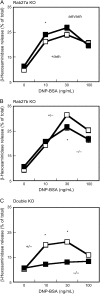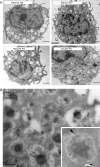Rab27b regulates mast cell granule dynamics and secretion
- PMID: 17587407
- PMCID: PMC2063611
- DOI: 10.1111/j.1600-0854.2007.00571.x
Rab27b regulates mast cell granule dynamics and secretion
Abstract
The Rab GTPase family regulates membrane domain organization and vesicular transport pathways. Recent studies indicate that one member of the family, Rab27a, regulates transport of lysosome-related organelles in specialized cells, such as melanosomes and lytic granules. Very little is known about the related isoform, Rab27b. Here we used genetically modified mice to study the involvement of the Rab27 proteins in mast cells, which play key roles in allergic responses. Both Rab27a and Rab27b isoforms are expressed in bone marrow-derived mast cells (BMMC) and localize to secretory granules. Nevertheless, secretory defects as measured by beta-hexosaminidase release in vitro and passive cutaneous anaphylaxis in vivo were found only in Rab27b and double Rab27 knockout (KO) mice. Immunofluorescence studies suggest that a subset of Rab27b and double Rab27-deficient BMMCs exhibit mild clustering of granules. Quantitative analysis of live-cell time-lapse imaging revealed that BMMCs derived from double Rab27 KO mice showed almost 10-fold increase in granules exhibiting fast movement (>1.5 microm/s), which could be disrupted by nocodazole. These results suggest that Rab27 proteins, particularly Rab27b, play a crucial role in mast cell degranulation and that their action regulates the transition from microtubule to actin-based motility.
Figures






Similar articles
-
Distinct and opposing roles for Rab27a/Mlph/MyoVa and Rab27b/Munc13-4 in mast cell secretion.FEBS J. 2013 Feb;280(3):892-903. doi: 10.1111/febs.12081. Epub 2013 Jan 2. FEBS J. 2013. PMID: 23281710
-
Rab27a and Rab27b regulate neutrophil azurophilic granule exocytosis and NADPH oxidase activity by independent mechanisms.Traffic. 2010 Apr;11(4):533-47. doi: 10.1111/j.1600-0854.2009.01029.x. Epub 2009 Dec 17. Traffic. 2010. PMID: 20028487 Free PMC article.
-
Rab27b is expressed in a wide range of exocytic cells and involved in the delivery of secretory granules near the plasma membrane.Mol Biol Cell. 2007 Nov;18(11):4377-86. doi: 10.1091/mbc.e07-05-0409. Epub 2007 Aug 29. Mol Biol Cell. 2007. PMID: 17761531 Free PMC article.
-
Rab27 effectors, pleiotropic regulators in secretory pathways.Traffic. 2013 Sep;14(9):949-63. doi: 10.1111/tra.12083. Epub 2013 Jun 10. Traffic. 2013. PMID: 23678941 Review.
-
The roles of Rab27 and its effectors in the regulated secretory pathways.Cell Struct Funct. 2003 Oct;28(5):465-74. doi: 10.1247/csf.28.465. Cell Struct Funct. 2003. PMID: 14745138 Review.
Cited by
-
Gross morphological features of the organ surface primo-vascular system revealed by hemacolor staining.Evid Based Complement Alternat Med. 2013;2013:350815. doi: 10.1155/2013/350815. Epub 2013 Aug 6. Evid Based Complement Alternat Med. 2013. PMID: 23986781 Free PMC article.
-
NADPH oxidase is internalized by clathrin-coated pits and localizes to a Rab27A/B GTPase-regulated secretory compartment in activated macrophages.J Biol Chem. 2012 Feb 10;287(7):4835-52. doi: 10.1074/jbc.M111.293696. Epub 2011 Dec 8. J Biol Chem. 2012. PMID: 22157766 Free PMC article.
-
Rab27b is Involved in Lysosomal Exocytosis and Proteolipid Protein Trafficking in Oligodendrocytes.Neurosci Bull. 2016 Aug;32(4):331-40. doi: 10.1007/s12264-016-0045-6. Epub 2016 Jun 21. Neurosci Bull. 2016. PMID: 27325508 Free PMC article.
-
Role of AP1 and Gadkin in the traffic of secretory endo-lysosomes.Mol Biol Cell. 2011 Jun 15;22(12):2068-82. doi: 10.1091/mbc.E11-03-0193. Epub 2011 Apr 27. Mol Biol Cell. 2011. PMID: 21525240 Free PMC article.
-
Posttraumatic stress disorder and breast cancer: Risk factors and the role of inflammation and endocrine function.Cancer. 2020 Jul 15;126(14):3181-3191. doi: 10.1002/cncr.32934. Epub 2020 May 6. Cancer. 2020. PMID: 32374431 Free PMC article. Review.
References
-
- Galli SJ, Kalesnikoff J, Grimbaldeston MA, Piliponsky AM, Williams CM, Tsai M. Mast cells as “tunable” effector and immunoregulatory cells: recent advances. Annu Rev Immunol. 2005;23:749–786. - PubMed
-
- Gilfillan AM, Tkaczyk C. Integrated signalling pathways for mast-cell activation. Nat Rev Immunol. 2006;6:218–230. - PubMed
-
- Siraganian RP. Mast cell signal transduction from the high-affinity IgE receptor. Curr Opin Immunol. 2003;15:639–646. - PubMed
Publication types
MeSH terms
Substances
Grants and funding
LinkOut - more resources
Full Text Sources
Other Literature Sources
Molecular Biology Databases
Research Materials

